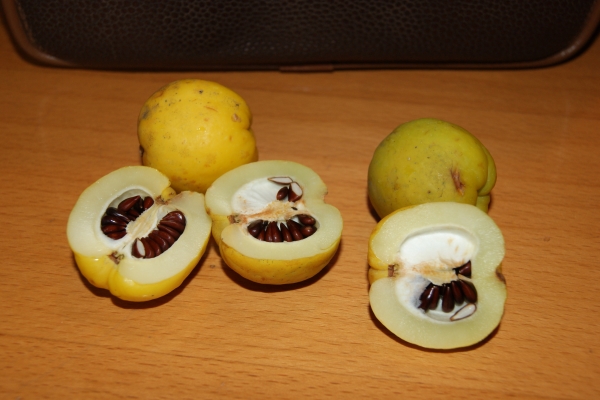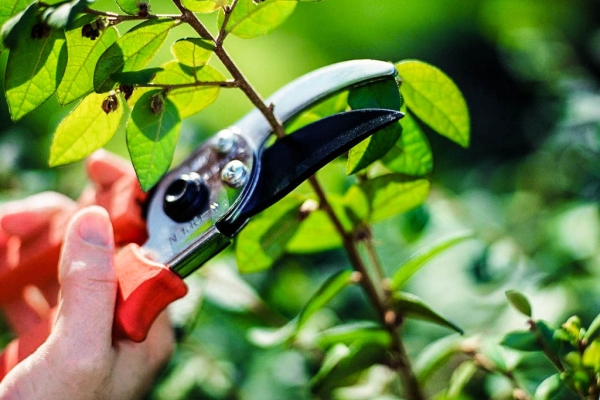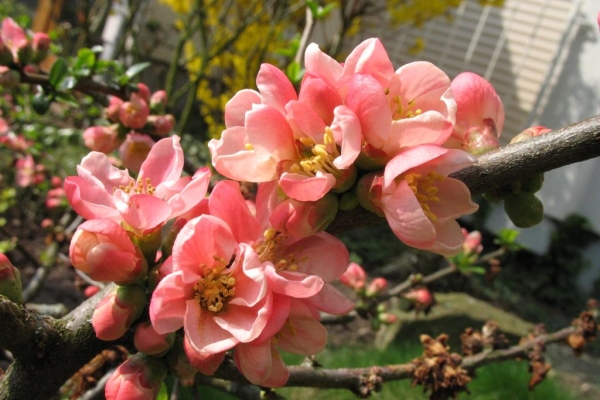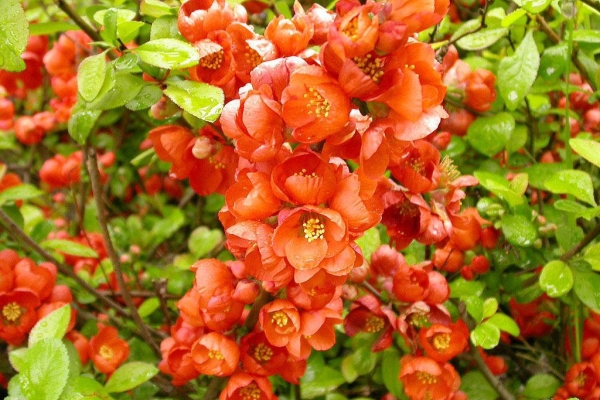If you want to decorate your plot, create an original hedge and at the same time harvest healthy fruits, notice the Japanese quince.
Table of contents
Description of ornamental shrubs, use in landscape design
Japanese quince - undersized ornamental shrub. She will decorate any garden in springwhen a lot of huge (for its small growth) orange-red flowers with a diameter of up to 4 cm, with which all the branches are covered, are blooming on it.
In the summer, the plant attracts the eye with its glossy foliage with flowing fruits. In the fall, it is covered with small yellow fruits.resembling small apples.
May shrub bloom and, due to the uneven opening of the buds, bright blooms stretch for 2-3 weeks.
Spirea, Forsythia and Magonia will be her worthy partners in garden compositions.
Quince has the ability to grow in breadth due to abundant root shoots, and this is its quality very often used to strengthen the slopes (it holds the soil).
With shrubs need to be careful, as in some varieties there are sharp spines.
Henomeles (Japanese quince) due to its frost tolerance (it can withstand temperatures down to -25 ° C) suitable for cultivation in the Moscow region. When frosts below - 30 ° C can freeze the buds, but the bush does not die.
With proper cultivation, shrubs grow to 40 years.
Japanese quince, or henomeles:
Planting and maintenance
Quince is not demanding for growing conditions, but there are several conditions that must be considered when planting a seedling:
- the planting place should be sunny, as in the shading the shrub grows and blooms poorly;
- in order to avoid freezing of bushes in harsh winters, landings should be carried out in places protected from northern winds;
- soil acidity should not exceed 6.5pH (slightly acid);
- having a taproot deep in the soil, the transplant does not tolerate a transplant from place to place poorly, we plant it immediately and forever;
- the distance between the bushes is 1-1.5 m, while the formation of a hedge is 0.8-1 m.
Landing rules:
- into the excavated planting pit (60 * 60 * 50cm) we pour out about a bucket of humus with wood ash (0.5 kg) and superphosphate (0.3 kg) added to it, mix it with a spade with a small amount of earth;
- we have a seedling in the hole in such a way that the root neck is at the level of the soil;
- we fall asleep the roots of the plant with earth and water well;
- the soil around the bushes is desirable to mulch (sawdust, chopped wood bark, peat).

Further care for the young sapling is in wateringHowever, it is impossible to prevent overmoistening of the soil in order to avoid rotting of the roots, regular loosening of the soil around the bushes.
Since at the time of landing all the necessary batteries were introduced, then no need to feed the plant for two years after planting.
Adult plants in the spring, after the snow melts, feed about 20 g of ammonium nitrate per bush. In the summer they give liquid fertilizing with organic matter (diluted mullein or bird droppings). In the autumn make superphosphate.
To do this, you can use a spruce spruce branches or cover small plants with a covering material (spandbond or lutrasil) and put wooden or plastic boxes on top and sprinkle them with the fallen leaves.
Fruiting quinces annual, starting from the third year after planting.
Chaenomeles cross-pollinated planttherefore, for better pollination and higher yields, 2-3 shrubs should be planted nearby.
Features landing chaenomeles:
Japanese Quince Breeding Methods for Transplanting
There are several ways of breeding Japanese quince.
Seeds
Due to the fact that during seed reproduction, varietal qualities are not preserved, it is used in the cultivation of rootstocks with further re-grafting.
Seeds collected from fruits are stored in wet sand at a temperature of about 0 ° C all winter (so they undergo stratification).
Seeds are sown in planting tanks in February - March, after 1.5 months they are swooping into separate containers and in late May and early June, seedlings are ready for planting in open ground.
Until the autumn, conduct regular watering and fertilizing., for the winter, the seedlings are still not completely cured and insulated with fallen leaves.
Germination of such seeds is excellentsince they have undergone natural stratification, in spring the dense shoots need to be thinned out, leaving the strongest ones. By autumn, seedlings are ready to transplant to a permanent place of growth.

Cuttings
Green cutting is carried out in early June.. Annual cuttings with a “heel” (a piece of last year's wood) are cut. Sections are processed "Kornevina" for better rooting and planted in shkalku tilted.
To maintain moisture cover planting plastic wrap. By autumn, seedlings are ready for transplanting to a permanent place, but it is better to do this in spring.
You can cut up the ripe cuttings in the fall, prikopat under a bush at a depth of 20-30 cm, be sure to mark the place.
During the winter, callus forms at the ends of the cuttings, and since the onset of spring, the cuttings are planted immediately to a permanent place.
Dividing bush
The easiest way to breed. From the uterine bush (root shoots) separate shoots with a well-developed root system and transplanted.
Horizontal layering
In quince often creeping shoots grow, prikopat that you can get seedlings for later reproduction.

Chaenomeles trimming rules
The shrub tolerates pruning very well, but most gardeners do not make it in vain because of the thorniness of the plant. Quince pruning needed to improve the growth and shaping of the crown for decorative purposes.
There are three types of trimming:
- Sanitary - dry, frozen and broken branches are removed in early spring.
- Formative - it begins to be done from the age of 4, when the branches begin to branch. The shoots growing inside the bush and thickening it are cut, remove excess root shoots, leaving no more than 2-3 young shoots per year to avoid strong growth of the bush in breadth. Creeping shoots are also removed, they take food on themselves and thicken the bush.
- Rejuvenating - it is produced from 8 years of age when the annual growth becomes less than 10 cm. Thin and elongated shoots are removed, leaving the strongest 10-12 in the bush. When thinning, you need to remember that the most productive shoots are 3-4 years old, older branches should be removed.
In order to avoid the penetration of diseases into the plant, all cuts should be treated with garden pitch.

Pests and diseases
Chaenomeles is not damaged by pests and is highly resistant to diseases, but in a cool and rainy summer, diseases such as are possible:
- leaf necrosis - the appearance of a gray plaque on the edge of the leaf with a further spread over the entire surface of the leaf, the leaves wither;
- cercosporiosis - appears as dark brown round spots lightening with time;
- ramulariasis - the formation of brown spots on the leaves.
Varieties for cultivation in the Moscow region
In central Russia, stunted varieties are grown to a height of 1 m, with arcuate branches and spreading crown.
Of the domestic varieties, the most common are:
- Fragrant - shrub up to 1.2 m, winter-hardy, fruit weight 50-60 g, with a pleasant aroma;
- Nikitskaya - early ripening, medium growth, winter hardy;
- Vitamin - winter-hardy, compact bush, bright yellow fruits weighing up to 100g;
- Muscat - large-fruited variety (fruits up to 200 g), self-pollinating, winter-hardy;
- Teplovskaya - variety of late ripening and long storage of fruits.
The most famous foreign varieties:
- Gayardi - variety with large orange flowers;
- Malardi - gorgeous pink with white border flowers;
- Papel - An interesting variety with yellow flowers and pink border around the edge of the petal.

Harvesting in the fall, fruit storage
Quince fruits are small, firm and sour in taste, but very aromatic. and with a high content of vitamin C. They are collected in September - October, before the onset of frost.
They are stored at air temperature of 1-2 ° С for 2-3 months. As a result of bedding, they become softer, sweet flavor increases.
Another of the fruits of henomelis prepare jams, jams, added to stewed fruit. Due to their high iron content, chopped fruits darken rapidly.
Japanese quince. Northern lemon:
Cooking jam
For 1 kg of quince you need: 2 kg of sugar and 1.5 cups of water.Quince wash, dry, remove seeds and hard white partitions, cut into small slices.
Put slices into boiling syrup, boil over low heat for 10 minutes, remove the froth, then remove from heat and leave for 12 hours. Boil the jam again for 10 minutes, etc. until the quince slices become transparent.
We put the finished jam on sterilized jars, leave it until winter. In winter, fragrant jam will remind you of the beauty of a flowering shrub and the approaching warm summer.
Japanese quince is unpretentious in growing, it is undemanding in attention and it is easy to care for it, but at the same time it is beautiful in bloom and useful in application.
